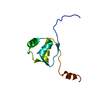+ データを開く
データを開く
- 基本情報
基本情報
| 登録情報 | データベース: PDB / ID: 7uiu | |||||||||
|---|---|---|---|---|---|---|---|---|---|---|
| タイトル | N2 sub-domain of IF2 bound to the 30S subunit in the Pseudomonas aeruginosa 70S ribosome initiation complex (focused classification and refinement) | |||||||||
 要素 要素 | Translation initiation factor IF-2 | |||||||||
 キーワード キーワード | RIBOSOME / Initiation Factor 2 / 70S ribosome / cryo-EM / translation initiation / initiator tRNA / conformational changes | |||||||||
| 機能・相同性 |  機能・相同性情報 機能・相同性情報translation initiation factor activity / translational initiation / GTPase activity / GTP binding / cytoplasm / cytosol 類似検索 - 分子機能 | |||||||||
| 生物種 |  Pseudomonas aeruginosa PAO1 (緑膿菌) Pseudomonas aeruginosa PAO1 (緑膿菌) | |||||||||
| 手法 | 電子顕微鏡法 / 単粒子再構成法 / クライオ電子顕微鏡法 / 解像度: 2.8 Å | |||||||||
 データ登録者 データ登録者 | Basu, R.S. / Sherman, M.B. / Gagnon, M.G. | |||||||||
| 資金援助 |  米国, 2件 米国, 2件
| |||||||||
 引用 引用 |  ジャーナル: Nat Commun / 年: 2022 ジャーナル: Nat Commun / 年: 2022タイトル: Compact IF2 allows initiator tRNA accommodation into the P site and gates the ribosome to elongation. 著者: Ritwika S Basu / Michael B Sherman / Matthieu G Gagnon /  要旨: During translation initiation, initiation factor 2 (IF2) holds initiator transfer RNA (fMet-tRNA) in a specific orientation in the peptidyl (P) site of the ribosome. Upon subunit joining IF2 ...During translation initiation, initiation factor 2 (IF2) holds initiator transfer RNA (fMet-tRNA) in a specific orientation in the peptidyl (P) site of the ribosome. Upon subunit joining IF2 hydrolyzes GTP and, concomitant with inorganic phosphate (P) release, changes conformation facilitating fMet-tRNA accommodation into the P site and transition of the 70 S ribosome initiation complex (70S-IC) to an elongation-competent ribosome. The mechanism by which IF2 separates from initiator tRNA at the end of translation initiation remains elusive. Here, we report cryo-electron microscopy (cryo-EM) structures of the 70S-IC from Pseudomonas aeruginosa bound to compact IF2-GDP and initiator tRNA. Relative to GTP-bound IF2, rotation of the switch 2 α-helix in the G-domain bound to GDP unlocks a cascade of large-domain movements in IF2 that propagate to the distal tRNA-binding domain C2. The C2-domain relocates 35 angstroms away from tRNA, explaining how IF2 makes way for fMet-tRNA accommodation into the P site. Our findings provide the basis by which IF2 gates the ribosome to the elongation phase. | |||||||||
| 履歴 |
|
- 構造の表示
構造の表示
| 構造ビューア | 分子:  Molmil Molmil Jmol/JSmol Jmol/JSmol |
|---|
- ダウンロードとリンク
ダウンロードとリンク
- ダウンロード
ダウンロード
| PDBx/mmCIF形式 |  7uiu.cif.gz 7uiu.cif.gz | 41.4 KB | 表示 |  PDBx/mmCIF形式 PDBx/mmCIF形式 |
|---|---|---|---|---|
| PDB形式 |  pdb7uiu.ent.gz pdb7uiu.ent.gz | 18.7 KB | 表示 |  PDB形式 PDB形式 |
| PDBx/mmJSON形式 |  7uiu.json.gz 7uiu.json.gz | ツリー表示 |  PDBx/mmJSON形式 PDBx/mmJSON形式 | |
| その他 |  その他のダウンロード その他のダウンロード |
-検証レポート
| アーカイブディレクトリ |  https://data.pdbj.org/pub/pdb/validation_reports/ui/7uiu https://data.pdbj.org/pub/pdb/validation_reports/ui/7uiu ftp://data.pdbj.org/pub/pdb/validation_reports/ui/7uiu ftp://data.pdbj.org/pub/pdb/validation_reports/ui/7uiu | HTTPS FTP |
|---|
-関連構造データ
| 関連構造データ |  26553MC M: このデータのモデリングに利用したマップデータ C: 同じ文献を引用 ( |
|---|---|
| 類似構造データ | 類似検索 - 機能・相同性  F&H 検索 F&H 検索 |
| 電子顕微鏡画像生データ |  EMPIAR-11012 (タイトル: Pseudomonas aeruginosa 70S ribosome initiation complex bound to compact IF2 EMPIAR-11012 (タイトル: Pseudomonas aeruginosa 70S ribosome initiation complex bound to compact IF2Data size: 1.7 TB Data #1: Unaligned multiframe micrographs of the Pseudomonas aeruginosa 70S ribosome initiation complex bound to IF2 collected on Gatan K3 in Super Resolution [micrographs - multiframe]) |
- リンク
リンク
- 集合体
集合体
| 登録構造単位 | 
|
|---|---|
| 1 |
|
- 要素
要素
| #1: タンパク質 | 分子量: 91049.641 Da / 分子数: 1 / 断片: N2 sub-domain of IF2 / 由来タイプ: 組換発現 / 詳細: Initiation Factor 2 由来: (組換発現)  Pseudomonas aeruginosa PAO1 (緑膿菌) Pseudomonas aeruginosa PAO1 (緑膿菌)遺伝子: infB, PA4744 / プラスミド: pET28a / 発現宿主:  |
|---|
-実験情報
-実験
| 実験 | 手法: 電子顕微鏡法 |
|---|---|
| EM実験 | 試料の集合状態: PARTICLE / 3次元再構成法: 単粒子再構成法 |
- 試料調製
試料調製
| 構成要素 | 名称: Focused map of the N2 sub-domain of IF2 bound to the 30S subunit in the 70S ribosome initiation complex タイプ: RIBOSOME / Entity ID: all / 由来: RECOMBINANT |
|---|---|
| 分子量 | 実験値: NO |
| 由来(天然) | 生物種:  Pseudomonas aeruginosa PAO1 (緑膿菌) Pseudomonas aeruginosa PAO1 (緑膿菌) |
| 由来(組換発現) | 生物種:  |
| 緩衝液 | pH: 7.6 |
| 試料 | 包埋: NO / シャドウイング: NO / 染色: NO / 凍結: YES |
| 試料支持 | グリッドの材料: GOLD / グリッドのタイプ: Quantifoil R2/1 |
| 急速凍結 | 装置: LEICA EM GP / 凍結剤: ETHANE / 湿度: 85 % / 凍結前の試料温度: 295 K |
- 電子顕微鏡撮影
電子顕微鏡撮影
| 実験機器 |  モデル: Titan Krios / 画像提供: FEI Company |
|---|---|
| 顕微鏡 | モデル: TFS KRIOS |
| 電子銃 | 電子線源:  FIELD EMISSION GUN / 加速電圧: 300 kV / 照射モード: FLOOD BEAM FIELD EMISSION GUN / 加速電圧: 300 kV / 照射モード: FLOOD BEAM |
| 電子レンズ | モード: BRIGHT FIELD / 倍率(公称値): 105000 X / 最大 デフォーカス(公称値): 2100 nm / 最小 デフォーカス(公称値): 200 nm / Cs: 2.7 mm |
| 試料ホルダ | 凍結剤: NITROGEN |
| 撮影 | 平均露光時間: 1 sec. / 電子線照射量: 31 e/Å2 フィルム・検出器のモデル: GATAN K3 BIOQUANTUM (6k x 4k) 撮影したグリッド数: 1 / 実像数: 8056 |
- 解析
解析
| EMソフトウェア |
| ||||||||||||||||||||||||||||||||||||||||
|---|---|---|---|---|---|---|---|---|---|---|---|---|---|---|---|---|---|---|---|---|---|---|---|---|---|---|---|---|---|---|---|---|---|---|---|---|---|---|---|---|---|
| CTF補正 | タイプ: PHASE FLIPPING AND AMPLITUDE CORRECTION | ||||||||||||||||||||||||||||||||||||||||
| 粒子像の選択 | 選択した粒子像数: 878576 | ||||||||||||||||||||||||||||||||||||||||
| 対称性 | 点対称性: C1 (非対称) | ||||||||||||||||||||||||||||||||||||||||
| 3次元再構成 | 解像度: 2.8 Å / 解像度の算出法: FSC 0.143 CUT-OFF / 粒子像の数: 123146 / 対称性のタイプ: POINT | ||||||||||||||||||||||||||||||||||||||||
| 原子モデル構築 | プロトコル: RIGID BODY FIT / 空間: REAL |
 ムービー
ムービー コントローラー
コントローラー



 PDBj
PDBj







